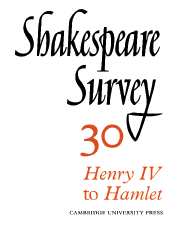Book contents
- Frontmatter
- ‘Henry IV’ and ‘Hamlet’
- Prince Hal and Tragic Style
- The True Prince and the False Thief: Prince Hal and the Shift of Identity
- Falstaff, the Prince, and the Pattern of ‘2 Henry IV’
- Whatever Happened to Prince Hal?: An Essay on ‘Henry V’
- ‘Henry V’ and the Bees’ Commonwealth
- ‘All’s Well that Ends Well’
- ‘Hamlet’ and the Power of Words
- Hamlet the Bonesetter
- ‘Hamlet’: A Time to Die
- Shakespeare, Lyly and Ovid: The Influence of ‘Gallathea’ on ‘A Midsummer Night’s Dream’
- Making a Scene: Language and Gesture in ‘Coriolanus’
- Freedom and Loss in ‘The Tempest’
- Inigo Jones at The Cockpit
- Theory and Practice: Stratford 1976
- The Year's Contributions to Shakespearian Study 1 Critical Studies
- 2 Shakespeare’s Life, Times, and Stage
- 3 Textual Studies
- Index
- Plate Section
Falstaff, the Prince, and the Pattern of ‘2 Henry IV’
Published online by Cambridge University Press: 28 March 2007
- Frontmatter
- ‘Henry IV’ and ‘Hamlet’
- Prince Hal and Tragic Style
- The True Prince and the False Thief: Prince Hal and the Shift of Identity
- Falstaff, the Prince, and the Pattern of ‘2 Henry IV’
- Whatever Happened to Prince Hal?: An Essay on ‘Henry V’
- ‘Henry V’ and the Bees’ Commonwealth
- ‘All’s Well that Ends Well’
- ‘Hamlet’ and the Power of Words
- Hamlet the Bonesetter
- ‘Hamlet’: A Time to Die
- Shakespeare, Lyly and Ovid: The Influence of ‘Gallathea’ on ‘A Midsummer Night’s Dream’
- Making a Scene: Language and Gesture in ‘Coriolanus’
- Freedom and Loss in ‘The Tempest’
- Inigo Jones at The Cockpit
- Theory and Practice: Stratford 1976
- The Year's Contributions to Shakespearian Study 1 Critical Studies
- 2 Shakespeare’s Life, Times, and Stage
- 3 Textual Studies
- Index
- Plate Section
Summary
A chief – perhaps the chief – fascination of the Henry IV plays is the rejection of Falstaff and the succession of Hal: this puzzle, as one observer has written, ‘divides the critics into Ephesians and Precise Brethren’. The sympathetic views of Morgann and Bradley have in this century been opposed by sterner stuff, so that those who cannot forgive Hal are now answered by those who find it hard to forgive Falstaff. Another area of lively discussion is the relationship of the two plays (or, perhaps, two parts of one play): here also the house divides without consensus. Generally, those who see 2 Henry IV as an inferior pot-boiler are those who regard it as a sequel, and vice versa. (There is some evidence that the Elizabethans were less enamoured of it than Part 1). On the other hand, some who argue that Henry IV is a ten-act play are attempting to link the three plays dealing with Hal, the whole tetralogy, or even both tetralogies: continuing lines of development, and continuing thematic interests like ‘kingship’ are stressed. But whichever view is espoused, the similarities between the plays tend to receive attention at the expense of their differences, as Professor G. K. Hunter points out: he suggests that we need to accept ‘the self-sufficiency of the separate play’. Whatever may be their formal relationship in the development of Shakespeare’s art, the two Henry IV plays are quite distinct in tone, imagery, and structure.
- Type
- Chapter
- Information
- Shakespeare Survey , pp. 35 - 46Publisher: Cambridge University PressPrint publication year: 1977



